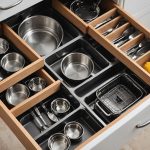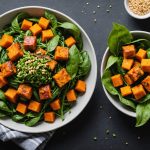Essential Blending Appliances
When it comes to blenders, choosing the right one can drastically enhance raw food preparation. High-performance blenders are vital in creating smooth textures, whether in nut butters, soups, or smoothies. They break down tough ingredients, ensuring consistent results and preserving nutrients. For those searching for a health-focused blending experience, certain features are indispensable. Look for a blender with variable speed settings, a powerful motor, and quality blades, which handle the rigours of raw food blending.
Health-focused blenders are engineered to process raw ingredients efficiently. Brands like Vitamix and Blendtec are renowned for blending efficiency, providing excellent models that are trusted in numerous kitchens. These models not only offer durability but also feature advanced technology that helps in retaining the nutritional integrity of ingredients.
Topic to read : Why You Should Buy Craft Alcohol Made in America for Your Home Bar
By investing in the right blending appliances, not only do you enhance the quality of your meals, but you also embrace the art of healthy living. The right choice of blender empowers you to experiment with various recipes, from vibrant green smoothies to creamy vegetable soups. It’s an essential companion for anyone passionate about exploring raw food diets with ease and precision.
Dehydration Equipment
Navigating the world of dehydrators is crucial for those passionate about raw food diets. When considering dehydrating as a preservation technique, understanding its importance is essential. Dehydrated fruits and vegetables maintain most of their nutrients while offering extended shelf life, combining nutrition with longevity. Selecting the right dehydration equipment for a restaurant kitchen involves examining options for efficiency, capacity, and ease of use.
Also to read : Flavorful Plant-Based Secrets: Masterful Tips to Enhance Vegan Cuisine at Your Restaurant
The choice of a dehydrator impacts not only the process of validating raw food nutrition but also the quality of the preserved food. Advanced models allow for temperature control, ensuring food isn’t overheated and nutrients remain intact. When choosing a dehydrator, consider models with multiple trays for increased capacity and machines that offer uniform heat distribution for consistent results.
Best practices for effective dehydration include slicing produce uniformly for even drying and storing finished products in airtight containers to prevent moisture absorption. It’s crucial to trial optimal drying times for different produce. Embracing these techniques ensures the integrity and full flavour of your food while managing kitchen resources efficiently. Prioritize dehydrators from reputable brands known for longevity and performance, making an informed choice for your raw food kitchen.
Food Processing Essentials
Food processors are vital in achieving efficiency in raw food kitchens, offering versatility for various tasks. They simplify raw food processing by facilitating functions like chopping, slicing, and mixing. This versatility not only saves time but also encourages the creation of diverse recipes, enhancing kitchen efficiency.
When choosing a food processor, aim for models with multiple speed settings and diverse blade options, proving their adaptability for different ingredients. Durability and performance are crucial; investing in quality models ensures long-term reliability, reducing the need for frequent replacements. Look for processors with robust motors capable of handling tougher ingredients often used in raw food diets.
Optimizing food processor use involves understanding each attachment’s role. For instance, using the dough blade helps with tough mixtures, while thin slicer blades are optimal for delicate cuts. Ensuring cleanliness between uses extends the life and hygiene of the equipment, maintaining its performance. Brands like Cuisinart and KitchenAid are well-regarded, providing models lauded for their durability and capability.
By leveraging the strengths of food processors, raw food enthusiasts can maintain efficiency, creativity, and a health-focused culinary approach. These appliances are indispensable companions, helping streamline tasks and empowering raw food kitchens to operate at peak performance.
Juicing Tools and Techniques
Juicing can be a game-changer for enhancing the nutritional intake in a raw food diet. Both centrifugal and masticating juicers have their merits, and understanding these can help in making the right choice for your kitchen needs. Centrifugal juicers operate quickly, slicing fruits and vegetables at high speed to extract juice, making them convenient for a busy kitchen setting. However, for those prioritizing nutrient extraction, masticating juicers might be preferable. They operate at a slower speed, grinding produce to retain more enzymes and nutrients, essential for a health-focused diet.
Incorporating fresh juice into a diet offers substantial nutritional benefits. The concentrated nutrients in fresh juices can provide an immediate energy boost and aid in digestion, making them a versatile addition to any raw food regimen. To enhance juicing efficiency, prioritize using produce that juices well in bulk, such as leafy greens and apples.
For practical juicing tips, maintain a clean juicing area, and select juicers that offer easy cleaning. This reduces downtime and maintains the hygiene of your kitchen appliances, contributing to a smoother workflow and ensuring consistent quality in your juice preparation.
Storage Solutions for Fresh Ingredients
Managing fresh ingredients in a raw food kitchen can be challenging, but choosing the right storage containers makes all the difference. To maintain ingredient quality and reduce waste, it’s essential to invest in airtight and durable solutions. These containers help preserve not only texture and flavour but also vital nutrients. For those conscious of environmental impact, eco-friendly options are increasingly available, often made from glass or BPA-free plastic.
Best practices for preserving ingredients include keeping perishable goods in appropriate conditions. Leafy greens, for example, thrive when wrapped in damp paper towels and stored in breathable bags. Meanwhile, using vacuum-sealed bags can significantly extend the shelf life of proteins and nuts. Ensuring optimal storage not only prevents spoilage but also contributes to efficient raw food preparation.
In terms of brand recommendations, Tupperware and Glasslock stand out for their integrity and design, offering solutions that prioritize food safety and environmental sustainability. These brands are well-regarded for providing products that are both functional and aesthetically pleasing, making them an excellent fit for any health-conscious kitchen. By adopting these storage practices, raw food enthusiasts can ensure their kitchen runs smoothly and sustainably.
Sustainable Kitchen Accessories
Incorporating eco-friendly tools in your kitchen not only contributes to environmental well-being but also enhances your raw food preparation experience. Opt for accessories crafted from sustainable materials such as bamboo and stainless steel. These materials are not only durable but also biodegradable or recyclable, aligning perfectly with a zero-waste lifestyle.
One of the primary benefits of using sustainable kitchen gear is their long-lasting nature, which reduces the need for frequent replacements and minimizes landfill contributions. For raw food enthusiasts, investing in high-quality, eco-friendly utensils is a step towards a healthier lifestyle and planet. Consider essential items like bamboo cutting boards and stainless steel strainers that incorporate both sustainability and practicality.
In terms of sourcing, various brands are committed to offering sustainable kitchen accessories. They focus on responsibly sourced materials and ethical production methods. By choosing utensils and tools from companies that prioritise sustainability, you are supporting practices that respect both human and environmental health.
Ultimately, embracing these raw food utensils can transform your kitchen into a more sustainable and efficient space. The thoughtful selection of products allows you to maintain alignment with your health goals while positively impacting the environment. This conscious approach to kitchenware is not only practical but also rewarding for eco-conscious cooks.
Optimizing Kitchen Layout and Workflow
In creating an efficient kitchen space, workflow optimization is essential. The physical layout directly impacts how seamlessly tasks are performed, especially in a health-focused raw food prep environment. Prioritizing accessibility to frequently used equipment, such as blenders and food processors, can reduce time and effort spent during meal preparation.
Consider designing your kitchen layout in logical zones: a washing area, prep space, and cooking zone. This organization supports a streamlined process, minimizing unnecessary movement. For maximum kitchen efficiency, ensure the arrangement accommodates key appliances and ingredients, providing ease of access without clutter.
When working with smaller spaces, vertical storage solutions can greatly benefit your kitchen’s functionality. Open shelving or wall-mounted racks keep surfaces clear, offering room for blending and processing activities. Efficient use of space not only enhances workflow but also maintains a clean, uncluttered work environment.
Practical tips include using multi-functional equipment to save space and time. An island or a rolling cart can add flexible prep areas and storage options. Efficient workflow and layout lead to a more enjoyable and productive raw food cooking experience, ensuring that your kitchen remains both functional and inspiring.




